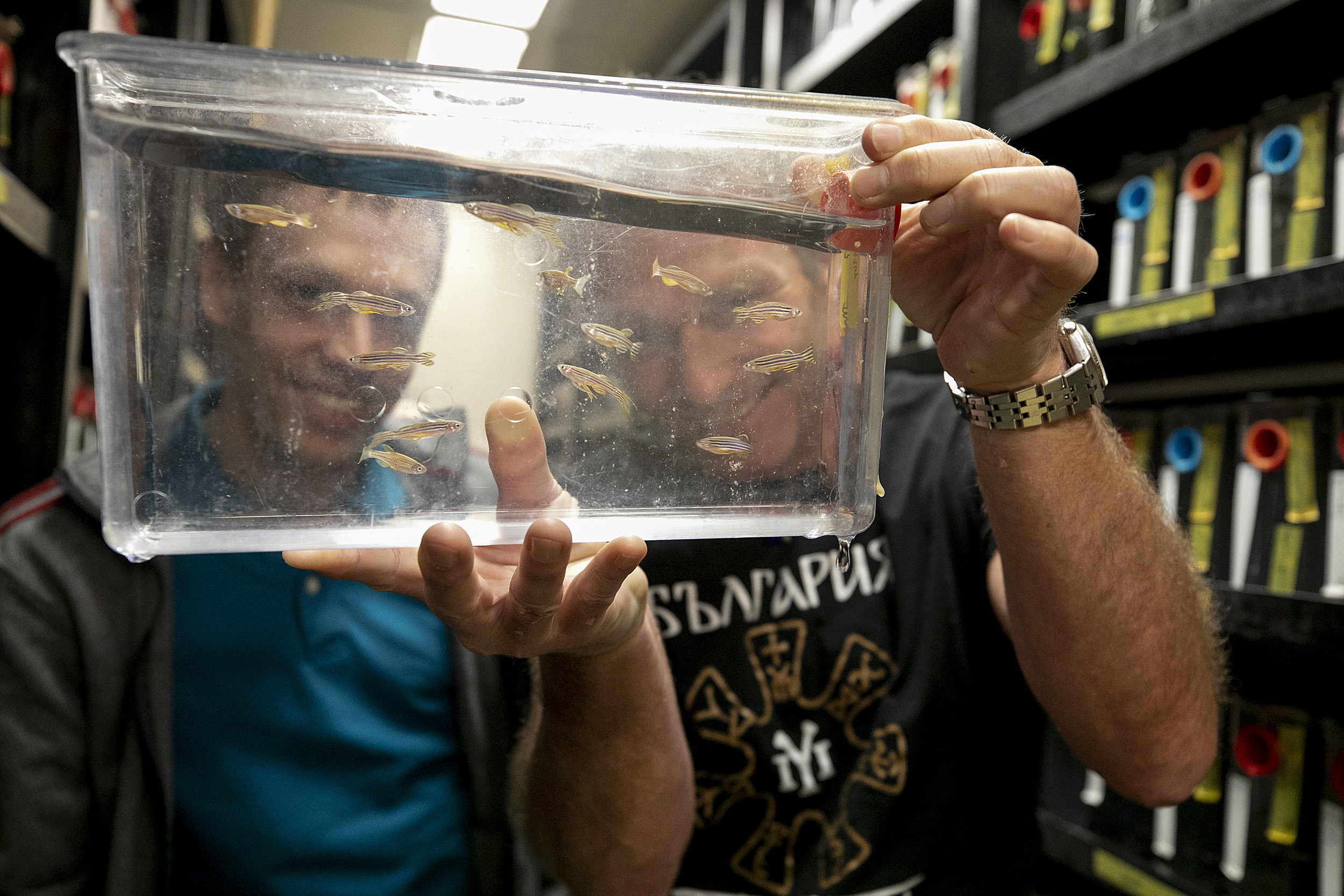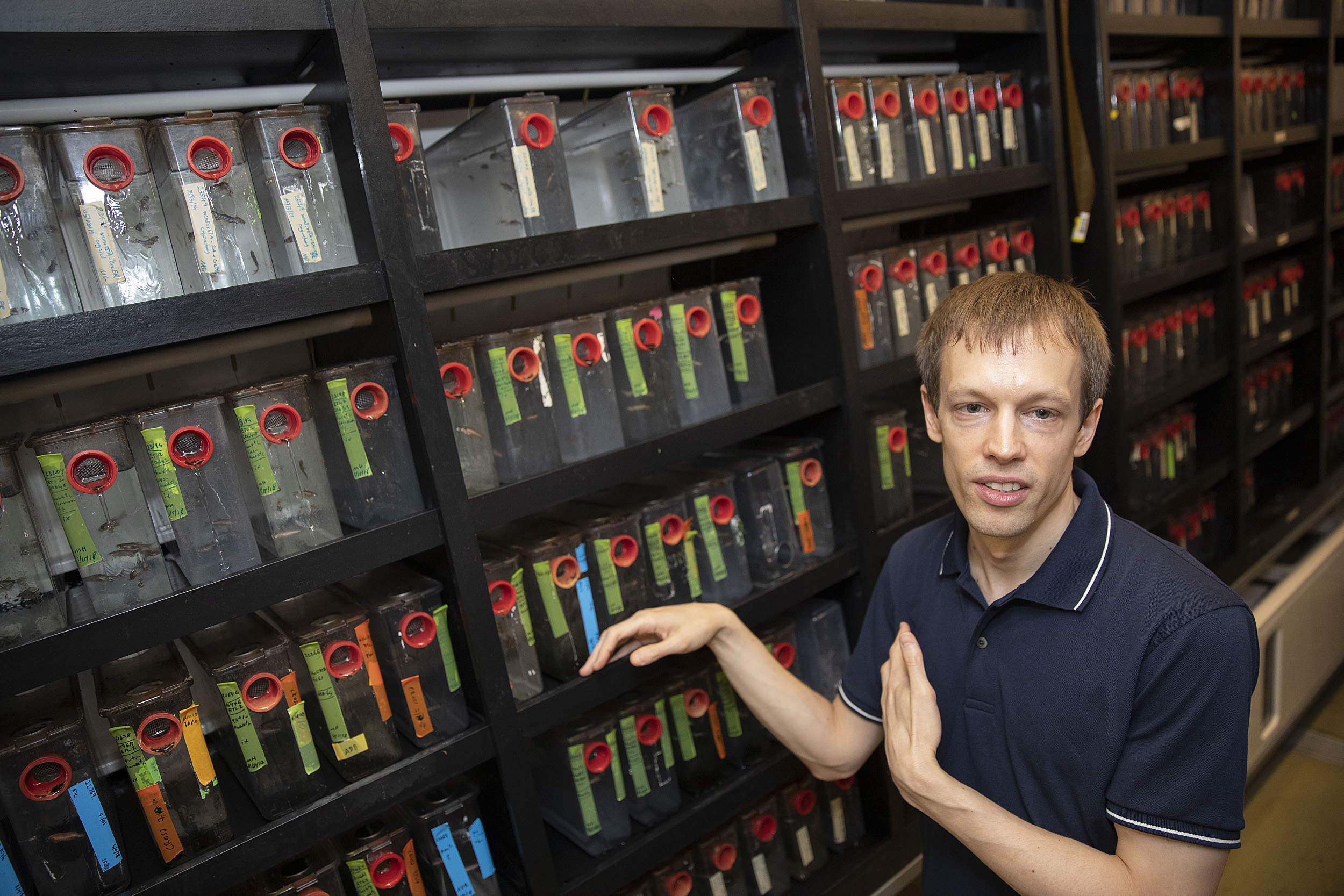
Martin Haesemeyer (left), in the labs of Florian Engert (right). Haesemeyer built an artificial neural network that almost perfectly mimicked the zebrafish and which has the potential to further understanding of biology.
Rose Lincoln/Harvard file photo
How a zebrafish model may hold a key to biology
Study: Artificial neural networks could be used to provide insight into biological systems
Teaching a computer to behave like a zebrafish wasn’t Martin Haesemeyer’s goal.
In fact, the research associate in the labs of Florian Engert, professor of molecular and cellular biology, and Alexander Schier, the Leo Erikson Life Sciences Professor of Molecular and Cellular Biology, was hoping to build a system that worked differently than zebrafish with an eye toward comparing how both process temperature information.
What he got instead was a system that almost perfectly mimicked the zebrafish — and that could be a powerful tool for understanding biology. The work is described in a July 31 paper published in Neuron.
“Initially, what I was curious about was some kind of comparison study, to look at zebrafish and something like Drosophila and see if their brains do this the same way,” Haesemeyer said. “And as a cheaper alternative than getting another animal to do it, I chose the artificial neural network, and I was surprised it worked so well.”
Using open-source software tools, Haesemeyer built a neural network with an architecture different from that of the zebrafish brain, gave it some basic rules on how to process temperature changes, and then allowed it to “learn” how to do it for itself.
“Essentially, what the network learns is … a filter function for extracting rates of change from a stimuli,” Haesemeyer said. “It makes what it thinks is the best movement, and then as the inputs change because it’s in a different place, it moves again, and starts to navigate the heat gradient. And after learning, it can do that quite well.”
But it wasn’t simply the network’s ability to navigate that interested Haesemeyer — it was the fact that it seemed to do it in a way identical to the fish.
“There were two things I looked at,” he said. “The first was, for lack of a better term, how well did its behavior compare to zebrafish? Does it follow similar rules to zebrafish? And indeed it does.
“I can also measure how quickly it integrates stimulus,” he continued. “I had earlier done that with zebrafish, and the results from the artificial network agree, so even though I didn’t tell the network that it should pay attention to the temperature every half-second, which the fish does, it learned a similar skill.”

Martin Haesemeyer explains the neural network in the Biology Laboratories.
Kris Snibbe/Harvard Staff Photographer
Haesemeyer then compared the artificial network to whole-brain imaging data he’d previously collected that showed how every cell in the zebrafish brain reacted to temperature stimulus. He found that the artificial “neurons” showed the same cell types as those found in the biological data.
“That was the first surprise — that there is actually a very, very good match between how the network encodes temperature and how the fish encode temperature,” he said. “And as a way to confirm that point a bit more … one thing we can easily do with the artificial network is remove certain cell types. When we removed all the cells that look like those in the fish, the network cannot navigate the gradient anymore, so that really indicates that what makes the network do what it does is the cells that look like those found in the fish.”
Haesemeyer thinks that it may be possible to create artificial networks for other animals. If it is, they could prove to be important guides to understanding biological networks.
“For example, there was one cell type in the network that I hadn’t found in the fish,” he said. “But since everything else seemed to match so well, I thought maybe I just didn’t find it because when you analyze whole-brain imaging you have to make certain trade-offs that make finding rare cell types difficult. And it turned out that this one cell type, which the network predicted and I hadn’t found, actually does exist in the fish.”
Though Haesemeyer said he doubts the day will come when artificial networks suffice for understanding complex behaviors — hypotheses will always need to be confirmed by biology — he believes the networks can serve as important tools.
“If you know what questions to ask, you will need to do considerably fewer experiments, and you could get to answers much faster than going hunting with a shotgun in the dark,” he said.
Haesemeyer said the finding also highlights the need for researchers to get a clearer understanding of precisely how such artificial networks operate.
“I do think it will become more important and interesting to study generally how these networks do these things, because it’s still very hard to disentangle what they are doing,” he said. “In this case, it worked because the input stimulus was fairly simple, but I do think there are interesting developments to be found in understanding how these networks accomplish their tasks that might teach us more about our brain.”
This research was supported with funding from an EMBO Long-Term Fellowship, the Jane Coffin Childs Fund for Medical Research, the National Institutes of Health, and a Simons Collaboration on the Global Brain research award.






